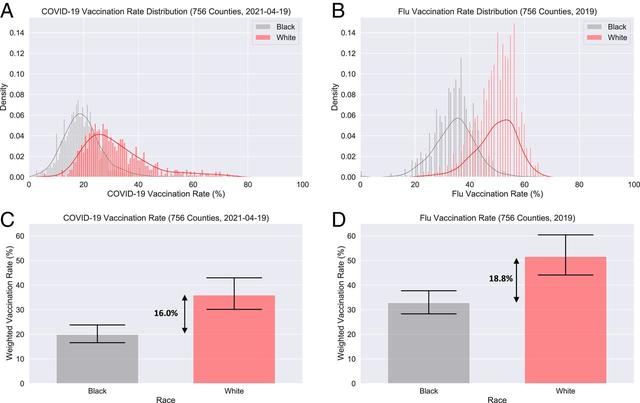Discussion
We find that CVD is associated with median income, education, and political ideology. In the face of an unprecedented pandemic (8), with significant resources invested in educating the public and distributing vaccines, these racial disparities persist without signs of abating over a 3-wk (27 March to 19 April 2021) period of a massive national vaccination campaign with a doubling of the vaccination rate (see SI Appendix). To the extent that another pandemic is almost inevitable, our findings underscore the importance of spotlighting the inequity in vaccination rates between Blacks and Whites.
Many of these variables have been associated with racial disparities in health in different contexts (3, 9). A clear theme in our results is the centrality of socioeconomic privilege and political ideology. Disparities in high school graduation rates were key drivers of CVD: A county in the 75th percentile of education disparity has a 10.7 percentage point difference in high school graduation rates between White and Black residents, corresponding to an estimated increase in CVD of 2.7 percentage points compared to a county with no high school disparities. This represents a substantial increase given the average CVD rate of 16.0 percentage points in our dataset.

Higher overall median incomes were associated with lower CVD. The difference between a county in the 75th percentile ($64,081) versus the 50th percentile ($54,517) of median income was associated with a 1.3 percentage point drop in CVD. With public health departments leading vaccine rollout coordination, this finding may speak to the additional resources available to higher income counties.
Republican vote share is significantly and negatively associated with CVD and FVD, with a stronger association for CVD, throwing the divisive societal and social media discourse surrounding the pandemic into sharp focus (10). In a February 2021 poll, Republicans expressed a significantly lower willingness to be vaccinated than Democrats (10). Even controlling for vaccine hesitancy, this is reflected in our finding that Republican vote share was strongly associated with less CVD, with a 1 percentage point decrease in CVD for each 2.5 percentage point increase in Republican vote share.
Counties with a greater proportion of Black residents have less disparity in COVID-19 vaccination rates. This pattern emerged despite inclusion of the cumulative COVID-19 cases in a county, controlling for potential disproportionate impact of COVID-19 in these communities (1, 2).
These patterns emerge after controlling for overall vaccine hesitancy in a county, challenging a popular media narrative that foregrounds Black hesitancy, triggered by mistrust in the medical establishment and a history of medical racism (11), as a root cause of disparities in vaccination. Our findings suggest that this might not be the case but rather that the observed disparities are a result of socioeconomic and political factors. Indeed, polls from February 2021 show that Blacks are more willing to get vaccinated than they were in November 2020 (10).









